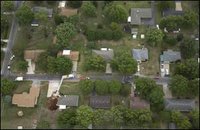The Nixa sinkhole - Part II
From what I've been reading online, it seems like the Nixa sinkhole is going to be filled, as it has been declared a "hazardous property" by the City of Nixa. From what I know and have heard, there seems to be little interest in discerning what caused the problem. Instead, the city wishes to solve the problem by an expedient method, keeping the cost below $100,000 total.
For the moment, all seems to be quiet on that front. Is there a cave below? Could it, if it were a cave below the sinkhole, reactivate? In 1977, a Pennsyvanian-age structure actually collapsed in the vicinity of Rainbow Drive in Jefferson City, Missouri, an event described by Jerry Vineyard, former deputy director of the Misssouri State Geological Survey in the book Geologic Wonders and Curiosities of Missouri. This sink was referred to as a "reactivated sink" Is the same in store for Nixa? We'll have to wait and watch.
For those of you who love pictures, I thought that I'd definitely show you more , taken from the air, and supplied from the website of KY-3 television in Springfield.


The photo on the left shows the subdivision that the sinkhole is in, and the one on the right shows an attempt to monitor the sinkhole from the end of a fire department "snorkel" truck. As of today, the sinkhole is now 80 feet in diameter. Will it continue to enlarge? With rain in the forecast, I'd say that enlargement will be a strong probability.
Until next time,
Trenchless Geologist

